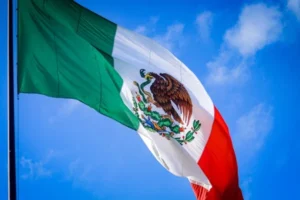Origins
The historic center and its origins date back to times when it turned out to be a land surrounded by canals suitable for navigation as the main means of transport in pre-Columbian times. Tenochtitlán recalls the settlement and confluence of several cultures being the Mexicans who definitely founded it as a ceremonial center in pre-Hispanic times. Shortly before the arrival of the Spanish colonizers it had already been constituted in the settlement of the Aztec power which exercised domination in other territories.
With the conquest it became Viceroyalty of New Spain undertaking numerous civil and religious constructions even cemented on some of pre-Columbian origin. With Mexican independence, all monarchical and noble character is eliminated, being the ruling country administrator of its destiny and opening the way to the great constructions that were undertaken at the beginning of the twentieth century.
The historic center was the nucleus of expansion of the city, protecting its historic buildings through decrees and with the awareness that it would be an obligatory site for national and world tourism. Today it remains the area of greatest economic, political, social, religious and cultural importance of the city.
Archaeological Zone
In the archaeological zone of the historic center, specifically in the Museum of the Templo Mayor, pre-Columbian, colonial and modern Mexico converge in the same place. It is located next to the Metropolitan Cathedral and a few meters from the National Palace. In its archaeological zone through excavations resurfaced the vestiges of the High Altar of the city of Tenochtitlán in 1978 and the discovery of the statuette of the goddess Coyolxauhqui. Later the Museum was inaugurated where the pieces found are exhibited which consists of eight permanent exhibition rooms.
The Templo Mayor is divided into two areas: an altar in honor of Tlaloc, god of rain and another, Huitzilopochtli, god of war. There are other important buildings such as three shrines, the House of the Eagles and the Great Basement.
The Central Zone
The Plaza de la Constitución or the Zócalo, is the most important square in Mexico, second in extension worldwide and the most important among Spanish-speaking countries. It is a large open and imposing space bordered by several civil and religious buildings, seat of the public authorities and a mandatory meeting place in the heart of the city. Since pre-Hispanic times it was the scene of great events.
It has also been constituted as a space for recreation, cultural presentations, civil protests and popular festivals, the most important being the one celebrated on September 15, mexico’s independence day. In the Zócalo is the Metropolitan Cathedral, a majestic religious building whose construction began in 1573 extending its culmination for 250 years.
Its eclectic architectural style responds to the trends that were in vogue during the long years in which its construction lasted and constitutes one of the most important churches in Latin America. The view offered by its bell tower of the city center is spectacular so it becomes the most visited site by tourists.
From the cathedral the construction of buildings was promoted responding to the Spanish way of ordering the city urbanistically. The church as a core building promotes the reorganization of the city with the construction of squares, hospitals and other civil buildings that gradually give it that attraction in its historical evolution.
Near the Cathedral is the National Palace, seat of the executive power and which houses works by the famous muralist Diego Rivera; the former City Hall Palace, a museum that houses the local executive power; the Government Building of Mexico City where administrative offices of government officials of the capital are located; and the Old Portal de Mercaderes as a commercial area since colonial times where buildings with shops, jewelry stores, hotels such as El Majestic and the Gran Hotel Ciudad de México were established.
Also noteworthy are the religious temples of San Bernardo in Baroque style; the Church and convent of Santo Domingo, Baroque temple with an interior altarpiece of neoclassical style; the Jesuit Temple of La Profesa or Oratory of San Felipe Neri; Church of Santa Veracruz; the Temple of San Hipólito on the Paseo de la Reforma, is the most visited site by believers and pilgrims where the image of San Judas Thaddeus is venerated; Church of San Fernando, built by Franciscan missionaries; all these buildings are located in the historic center and represent a great alternative for religious tourism. In its naves, altars and altarpieces are exhibited pieces of jewelry and blacksmithing of great artistic finish that turn them into true museums surpassing their original character.
On one side of the Zócalo we find the old Archbishop’s Palace built in 1530 in the Baroque style and headquarters of the Museum of the Ministry of Finance and Public Credit. In 1931 it became the historical heritage of the city.
The Mining Palace is a majestic example of neoclassical architecture in America and has housed different university institutions. It currently functions as a Museum attached to the Faculty of Engineering of the National Autonomous University of Mexico.
The Palace of the School of Medicine, former Palace of the Inquisition, functions as the Museum of Medicine of the National Autonomous University of Mexico. Also the Post Office Palace or Postal Palace, presents inside a decorative work of filigree and is of Venetian style. The Palace of Fine Arts in the heart of the city, is the main stage of artistic and cultural presentations of Theater, Dance, Opera and Ballet of the Mexican capital. It is artistic heritage and its construction dates from the early twentieth century with a beautifully decorated façade. Inside it houses frescoes by the main artists of the Mexican muralist movement.
The National Museum of Architecture also operates there and is home to important music and dance groups. It is the obligatory stage for important concerts having a stall for 2000 people. Mexico does not cease to amaze by the vitality of its center where colonial, republican and modern monuments coexist such as the Palace of Fine Arts or other buildings dating from the last century.
Of the best places in Mexico City
The historic center offers you an excellent alternative to rest with the park of La Alameda Central. Its construction dates back to the sixteenth century passing through different facets until resuming its original objective which was to become a place of refuge and tranquility while hiking under the poplars and willows, taking from there its name for the trees that were planted there in its opportunity.
For the seventeenth century changes were made with the construction of fountains inspired by the Gardens of Versailles in addition to having a small square inside. The tourist needs many hours to make the tour of the center, so the park is an excellent alternative for rest while making the journey. In addition, workers, office workers, street vendors and passers-by from the center converge to enjoy a moment of tranquility before returning to their work.
The historic center has its icon of modernity in the Latin American Tower, a skyscraper consisting of 44 floors. Inspired by the constructive premises of modern architecture, it stands out in the historic center of the city with an aluminum and glass façade based on a steel structure or frame. Inside there are offices, cafes, exhibition rooms, restaurant-bar, museums and a large terrace that works as a viewpoint which is an excellent alternative for recreation and recreation.
Plaza Garibaldi, at the northern end of the historic center, is a destination that you can not miss to know Mexican music and enjoy the mariachis that make life in it. The tourist can pay for their services to provide a moment of serenades to relatives, loved ones and lovers. The musicians arrive at dusk with their large hats, typical charro costumes with chaparreras, buckles in pants and armed with their instruments to liven up the nights.
Around the square you have reference places such as the bar in Garibaldi Square where it is said that the presentation of mariachis began in the city. There is also the Tenampa Hall from where it is known that the first mariachi arrived in the city from Guadalajara. On one side of the square is the Museum of Tequila and Mezcal, typical Mexican liquors taken from the agave plant. There you can observe its distillation process as well as the tasting of different variants of this popular Mexican drink.
Mexico City offers you a variety of alternatives when it comes to Museums, Galleries and exhibition hall. The National Museum of Art built in the last years of the government of Porfirio Díaz, exhibits a collection of Mexican art from the sixteenth to the twentieth century. The Franz Meyer Museum, famous French antique shop that donated countless objects and that are exhibited in the building of the S. XVI where the San Juan de Dios hospital worked and which was inaugurated as a museum in 1986. The National Museum of Cultures (former Mint) opened in 1966 where various pieces and objects of international culture are displayed.
The Museum of The Caricature and Hall of the Mexican Plastic that works in the College of Christ. The Academy of San Carlos where classes in engraving, painting, sculpture and architecture were taught was inaugurated in 1785. Its building was remodeled in 1846 and to which the library and the assembly hall are attached. The Site of the Printing House of America, converted into a Museum of the Book.
The Museum of the Mexican Army and Air Force was inaugurated in 1993 in the old Betlemitas museum and has to its credit to bring closer to the war events that forged Mexican history. The Alameda Art Laboratory where contemporary art is exhibited. The Diego Rivera Mural Museum in the old parking lot of the Regis Hotel where the famous mural Sueño de una Tarde Dominical is exhibited in the Alameda Central. The Museum of the Estanquillo and of course the Museum of the Templo Mayor.
To finish this walk through the central area we can not fail to mention the variety of Mexican cuisine offered in inns and restaurants. One of these emblematic sites is the Café Tacuba, the most important opened in 1912 in a colonial house of the seventeenth century. Famous Mexican dishes such as enchiladas verdes and tamales are served there.
Mexico City with its historic center is still a reference site for world tourism. Its convergence of the ancient with the modern makes it possess a great cultural syncretism, the Spanish and the ethnic in an unparalleled symbiosis, facing the future to continue expanding as a great metropolis.










